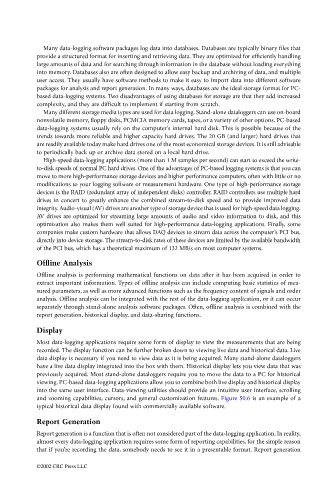Page 1230 - The Mechatronics Handbook
P. 1230
Many data-logging software packages log data into databases. Databases are typically binary files that
provide a structured format for inserting and retrieving data. They are optimized for efficiently handling
large amounts of data and for searching through information in the database without loading everything
into memory. Databases also are often designed to allow easy backup and archiving of data, and multiple
user access. They usually have software methods to make it easy to import data into different software
packages for analysis and report generation. In many ways, databases are the ideal storage format for PC-
based data-logging systems. Two disadvantages of using databases for storage are that they add increased
complexity, and they are difficult to implement if starting from scratch.
Many different storage media types are used for data logging. Stand-alone dataloggers can use on-board
nonvolatile memory, floppy disks, PCMCIA memory cards, tapes, or a variety of other options. PC-based
data-logging systems usually rely on the computer’s internal hard disk. This is possible because of the
trends towards more reliable and higher capacity hard drives. The 20 GB (and larger) hard drives that
are readily available today make hard drives one of the most economical storage devices. It is still advisable
to periodically back up or archive data stored on a local hard drive.
High-speed data-logging applications (more than 1 M samples per second) can start to exceed the write-
to-disk speeds of normal PC hard drives. One of the advantages of PC-based logging systems is that you can
move to more high-performance storage devices and higher performance computers, often with little or no
modifications to your logging software or measurement hardware. One type of high-performance storage
devices is the RAID (redundant array of independent disks) controller. RAID controllers use multiple hard
drives in concert to greatly enhance the combined stream-to-disk speed and to provide improved data
integrity. Audio-visual (AV) drives are another type of storage device that is used for high-speed data logging.
AV drives are optimized for streaming large amounts of audio and video information to disk, and this
optimization also makes them well suited for high-performance data-logging applications. Finally, some
companies make custom hardware that allows DAQ devices to stream data across the computer’s PCI bus,
directly into device storage. The stream-to-disk rates of these devices are limited by the available bandwidth
of the PCI bus, which has a theoretical maximum of 132 MB/s on most computer systems.
Offline Analysis
Offline analysis is performing mathematical functions on data after it has been acquired in order to
extract important information. Types of offline analysis can include computing basic statistics of mea-
sured parameters, as well as more advanced functions such as the frequency content of signals and order
analysis. Offline analysis can be integrated with the rest of the data-logging application, or it can occur
separately through stand-alone analysis software packages. Often, offline analysis is combined with the
report generation, historical display, and data-sharing functions.
Display
Most data-logging applications require some form of display to view the measurements that are being
recorded. The display function can be further broken down to viewing live data and historical data. Live
data display is necessary if you need to view data as it is being acquired. Many stand-alone dataloggers
have a live data display integrated into the box with them. Historical display lets you view data that was
previously acquired. Most stand-alone dataloggers require you to move the data to a PC for historical
viewing. PC-based data-logging applications allow you to combine both live display and historical display
into the same user interface. Data-viewing utilities should provide an intuitive user interface, scrolling
and zooming capabilities, cursors, and general customization features. Figure 50.6 is an example of a
typical historical data display found with commercially available software.
Report Generation
Report generation is a function that is often not considered part of the data-logging application. In reality,
almost every data-logging application requires some form of reporting capabilities, for the simple reason
that if you’re recording the data, somebody needs to see it in a presentable format. Report generation
©2002 CRC Press LLC

